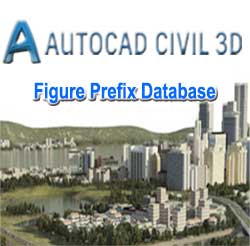 As discussed, the linework code set handles how the field codes are translated into linework commands, but what happens to those features once they are drawn? What layer are they drawn on? Do they have any special purpose such as a property line or breakline? The Figure Prefix Database is the means by which these decisions can be made up front for specific codes. For example, any feature drawn through points coded EP will be drawn on the pavement layer and tagged as a key component for establishing a “hard edge” in the 3D model of the terrain, also known as a breakline.
As discussed, the linework code set handles how the field codes are translated into linework commands, but what happens to those features once they are drawn? What layer are they drawn on? Do they have any special purpose such as a property line or breakline? The Figure Prefix Database is the means by which these decisions can be made up front for specific codes. For example, any feature drawn through points coded EP will be drawn on the pavement layer and tagged as a key component for establishing a “hard edge” in the 3D model of the terrain, also known as a breakline.To assign a Figure Prefix Database to your drawing and apply it to survey data that has been imported, follow these steps:
- Open the drawing named Figure Prefix Database.dwg or (Figure Prefix Database.dwg (METRIC)) located in the Exercise_03 class data folder.
- On the Survey tab of the Toolspace, click the Edit Survey User Settings icon in the top-left corner.
- Click the Browse icon next to Figure prefix database path. Browse to and select the Exercise_03 class data folder.
- Click OK to dismiss the Survey User Settings dialog box. Right-click Figure Prefix Databases and select Refresh. Click the plus sign next to Figure Prefix Databases to expand its contents. You should now see Essentials listed under Figure Prefix Databases.
- Right-click Essentials and select Make Current. Right-click Essentials again and, this time, select Manage Figure Prefix Database.
- Scroll down and examine the codes in the Name column. These match the codes that you saw in the text file containing the survey data. Notice that some of the codes are designated as breaklines, such as EP (edge of pavement), TOPD (top of ditch), and TOB (top of bank). The breakline designation means that these lines can be used to define hard edges in a surface model. Also note the layers that are assigned by code.
- Click Cancel to dismiss the Figure Prefix Database Manager dialog box.
- If the contents of the Essentials 3 survey database are not visible, right-click Essentials 3 and select Open for edit.
Tips :The Essentials 3 database is the result of correctly completing the previous exercise. This database is provided to ensure that you start the current exercise with the correct version.
- Expand Import Events. Right-click Topo Survey.txt and select Process Linework.
- In the Process Linework dialog box, select Essentials for Current figure prefix database and click OK. Civil 3D will redraw the linework, this time doing so on the appropriate layers. This is evident in the linetypes that are applied to the treelines and fence lines, which are now appropriately represented on the drawing (see Figure).

The appearance of the drawing makes more sense now that features such as fence lines and treelines have been drawn on the appropriate layers.


Survey Figures
At this point, you may be wondering what the word figure means, or specifically, what is a survey figure. A Civil 3D survey figure is the program’s way of representing a linear feature that has been defined using survey data. A survey figure is commonly used to represent visible features such as fence lines, edges of pavement, and treelines as well as topographic features such as tops and bottoms of embankments. The topographic feature line layers are usually turned off when the drawing is plotted. Survey figures can be referenced by other Civil 3D objects such as surfaces, feature lines, and corridors, enabling design work to tie into existing features and topography where applicable.
